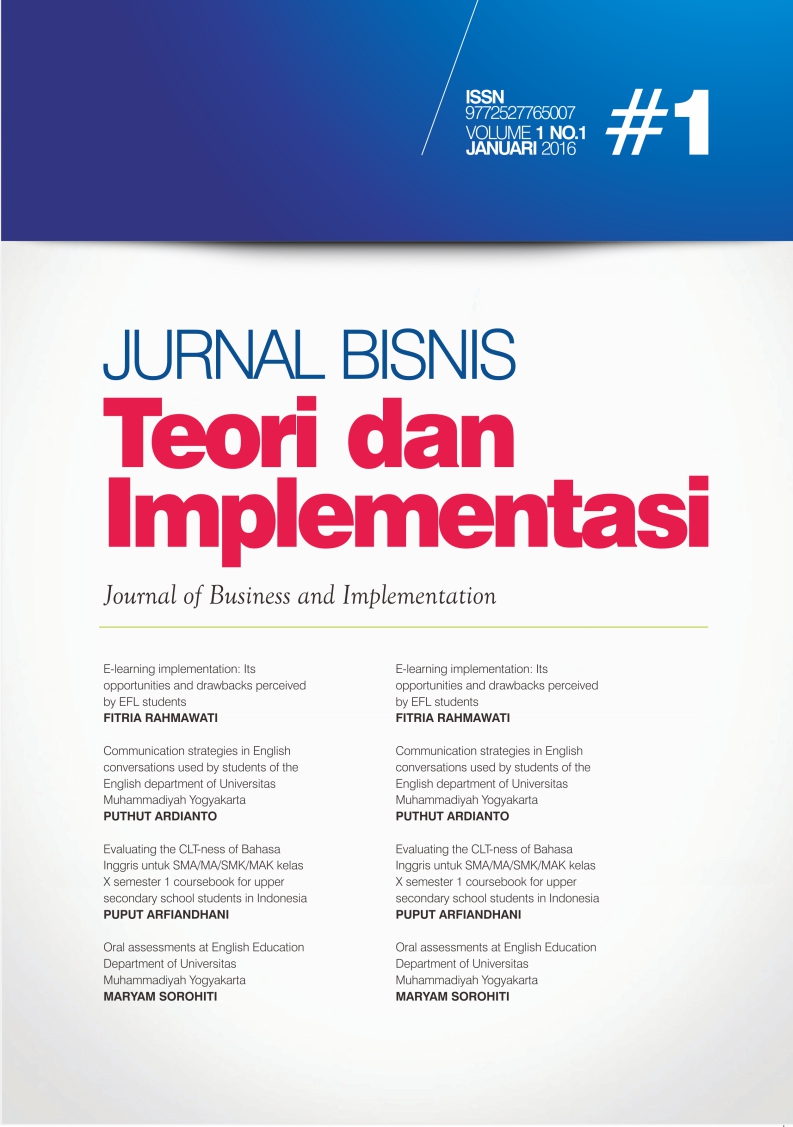The Structure and Performance Analysis: Empirical Study on Commercial Banking in Indonesia 2010 – 2019
DOI:
https://doi.org/10.18196/jbti.v13i2.15233Keywords:
Structure, Performance, Bank, Indonesia,Abstract
The purpose of this paper is to conduct an empirical study about the structure and performance of the banking sector in Indonesia with several specific factors which influenced the firms and the other control variables. This study used panel data which are the secondary data, total asset, ROA, CAR, LDR, and ROE ranging from 2010 to 2019. The sources are taken for the last ten years which is from the form of bank financial statements published by Bank Indonesia and Indonesian banking statistics published by the Indonesia financial services authority as well as from annual financial statements of each bank. In order to measure structure, this paper used concentration ratio as well as HHI for four large banks, to know the performance of the firm, this study used Return on Asset data, and to analyze the relationship between structure and performance, it used simple linear regression. This paper found that Indonesian banking has a high concentration, it proved from the value of HHI is more than 2500, and the value of CR4 shows between 40% and no more than 60%. It shows that the Indonesian banking sector is an Oligopoly market. Following further, there is a negative relative between the structure and performance of the firm proving the result of regression between total assets and CR4 for ten years.
References
Beers, B. (2020, February 19). Investopedia. Retrieved July 15, 2020, from Regression Definition: Dianitasari, N., and Hersugondo, H. (2020). Pengaruh Struktur Dan Konsentrasi Kepemilikan, Model Bank Pada Kinerja Perbankan. Jurnal Benefita, 5(2), 162. https://doi.org/10.22216/jbe.v5i2.5315
Naylah, M. (2010). Pengaruh Struktur Pasar Terhadap Kinerja Industri Perbankan Indonesia. MM Undip TESIS.
Nisa, C., Mukri, C., Djamil, A., Ekonomi, F., and Pancasila, U. (2019). Struktur Pasar dan Kinerja: Studi Kasus pada Bank Umum di Indonesia. Jurnal Riset Manajemen Dan Bisnis, 4(3), 375–384.
Pertiwi, Y. N. (2013). Pengaruh Struktur Pasar Industri Perbankan Dan Karakteristik Bank Terhadap Profitabilitas Bank Konvensional Di Indonesia Periode 2006-2011. Universitas Diponegoro, 1–84.
Yudaruddin, R. (2014). Dampak Tingkat Konsentrasi Terhadap Kinerja Dan Stabilitas Perbankan Di Indonesia Tahun 2003-2013. Jurnal Keuangan Dan Perbankan, 18(2), 278–286.
https://www.investopedia.com/terms/r/regression.asp
Belengkaehe, R., Engka, D., and Mandeji, D. (2014). Analysis of Stucture, conduct, performance Banking Industry in Indonesia (In case of registered Banking in Indonesia Stock Exchange from 2008 to 2012). Berkala Ilmiah Efisiensi, 43-54.
Bello, M., and Isola, W. A. (2014). Empirical analysis of structure-conduct-performance paradigm on Nigerian banking system. The Empirical Econometrics and Quantitive Economics Letter, 24-34.
Bhatti, G. A., and Hussain, H. (2010). Evidence on Structure Conduct Performance Hypothesis in Pakistani Commercial Bank . Business Management, 174-187.
Jedicka, L., and Jumah, A. (2006). The Austrian Insurance Industry: A Structure, Conduct and Performance Analysis.
Khan, H. H., Ahmad, B. R., and Chan, S. G. (2018). Market Structure, Bank Conduct and Bank Performance: Evidance from ASEAN. Policy Modelling, 25.
Mohammed, N., Islmail, A. G., and Muhammad, J. (2015). Evidence On Market Concentration In Malaysia Dual Banking System. Procedia - Social and Behavioural Sciences , 169-176.
Molyneux, P., and Forbes, W. (1995). Market structure and performance in European banking. Applied Economics, 155-159.
Moudud-UI-Huq, S. (2020). Does Bank Competition Matter For Performance and Risk Taking? Empirical Evidence From BRICS Countries. International Journal of Emerging Market, 1746-8809.
Natalia, T. C., Deoranto, P., and Effendi, M. (2011). Analysis of the structure, behavior, and performance in industrial markets Bakpia, Yogyakarta. Industria, 50-56.
Polius, T., and Samuel, W. (2002). Banking Efficiency In The Eastern Caribbean Currency Union; An Examination of The Structure-Conduct-Performance Paradigm and Efficiency Hypothesis. Centro de Estudios Monetarios Latinoamericanos, CEMLA, 75-92.
Sahile, S. W., Tarus, D. K., and Thomas, C. K. (2015). Market structure-performance hypothesis in Kenyan banking industry. International Journal of Emerging Market, 10, 697-710.
Samad, A. (2007). Market Structure, conduct, and performance: Evidence from Bangladesh banking system. Journal of Asian Economics, 181-193.
Sathye, S., and Sathye, M. (2004). Structure, Conduct, and Performance Relationhsip in Indian Banking. Indian School of Political Economy, 1-11.
Sitanggang, L. M. (2019, 2 7). Kontan.co.id. Retrieved 7 5, 2020, from The number of banks in Indonesia will be increasingly lean, this is of benefit to the industry: https://keuangan.kontan.co.id/news/jumlah-bank-di-indonesia-bakal-semakin-ramping-ini-manfaatnya-bagi-industri
Tan, Y. (2016). The Measurement of Bank Efficiency and Bank Competition in China. Efficiency and Competition in Chinese Banking, 93-116.
Williams, D. M., Molyneux, P., and Thornton, J. (1994). Market Structure and performance in Spanish banking. Journal of Banking and Finance, 433-443.
Yudrauddin, R. (2012). Market Structure, Conduct, and Performance Effidence from Indonesia Banking Industry. Jornal of Economics and Finance, 229-317.
Zdaniuk B. (2014) Ordinary Least-Squares (OLS) Model. In: Michalos A.C. (eds) Encyclopedia of Quality of Life and Well-Being Research. Springer, Dordrecht
Downloads
Published
Issue
Section
License
JBTI : Jurnal Bisnis : Teori dan Implementasi is licensed under  Creative Commons Attribution Attribution-NonCommercial-NoDerivatives 4.0 International License.
Creative Commons Attribution Attribution-NonCommercial-NoDerivatives 4.0 International License.
Authors who publish with this journal agree to the following terms:
- Authors retain copyright and grant the journal right of first publication with the work simultaneously licensed under a Creative Commons Attribution Attribution-NonCommercial-NoDerivatives 4.0 International License that allows others to share the work with an acknowledgment of the work's authorship and initial publication in this journal.
- Authors are able to enter into separate, additional contractual arrangements for the non-exclusive distribution of the journal's published version of the work (e.g., post it to an institutional repository or publish it in a book), with an acknowledgment of its initial publication in this journal.
- Authors are permitted and encouraged to post their work online (e.g., in institutional repositories or on their website) before and during the submission process, as it can lead to productive exchanges and earlier and greater citation of published work (See The Effect of Open Access).



